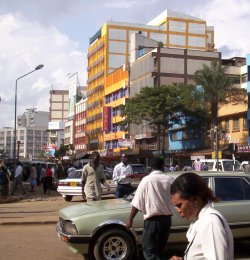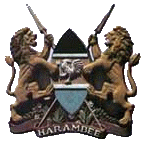|
TOURISM
IN KENYA
Great Rift Valley
Beautiful
countryside
Hotels
& Lodges
Kenya's
Coast
Economy
Government >
Kenya
National
Parks
Lake
Victoria
The
People of Kenya
Wildlife

Kenya is a democratic country,
where people are allowed to hold peaceful protests.

The government of Kenya has
ensured the peace, stability and development of the country, enabling
the people to engage purposefully in commercial activities.
LINKS:
The Office of
the President
|

Kenya has been a
parliamentary democracy since independence in 1963. Our structure of
government closely resembles that of Britain.
Government in Kenya is composed of three arms: the
Executive, the Legislature (Parliament) and the Judiciary (the Courts
System). The Head of State has overall executive responsibility over
the government and is elected through a popular vote held every five
years.
The current Head of State is President Mwai Kibaki, elected in December
2002 as a candidate of the National Rainbow Coalition (NARC), an
amalgamation of at least 17 political parties.
The arms of government:
THE
EXECUTIVE ARM OF GOVERNMENT
The Executive is under the direct supervision of the President and its
function in government is to implement government policy in accordance
with Acts of Parliament, to maintain law and order and to preserve the
nationís territorial integrity. The Executive is, in addition,
responsible for managing the economy through sound fiscal measures and
as instructed by the legislature.
The security forces (army, navy,
airforce, police) are under the direct supervision of the Executive
branch of government. The Executive is represented countrywide by the
Provincial Administration structure consisting of Provincial
Commissioners, District Commissioners and drilling down to the village
level with Chiefs and Assistant Chiefs. The role of the Provincial
administration is, as the name suggests, to administer the country by
maintaining law and order, running government offices, coordinating
development projects initiated by local people and non-governmental
organizations.
Kenyaís President has powers to appoint cabinet ministers, civil
servants, military officers, judicial office holders and other public
officials. The President can dissolve or prorogue Parliament, call
elections or declare war.
Top
THE LEGISLATURE
Consists of a single chamber Parliament, currently constituted by 222
Members of Parliament (MPís). The President sits in Parliament by
virtue of being an elected MP. The Attorney General (AG) is also a
Member of Parliament in an ex-officio capacity. Kenyan MPís represent a
number of registered political parties. There are over 42 political
parties though less than half managed to get representatives elected to
Parliament.
Kenya's parliament has no
provision for special interest groups (women, professionals, military,
youth, religion) though the political parties are encouraged to
consider such interests during their nominations.
The role of Parliament is to debate matters of government and to pass
bills for the onward approval of the President. The President has
powers to veto a bill and return it to the Legislature with recommended
modifications. Once approved and signed by the President, a bill
becomes an Act of Parliament and is legally binding as a law.
MPís also bring to the House development and security matters affecting
their individual constituencies. The National Budget has to be
presented before Parliament annually for debate before the Ministry of
Finance implements it.
Top
THE
JUDICIARY
Kenyaís Judiciary is headed by the Chief Justice, while the highest
Court is the Court of Appeal, of which the Chief Justice must have
served as a Judge. Below the Court of Appeal come the High Courts,
Senior Magistrates Courts and District Courts, not necessarily in that
order. The function of the Judiciary is to hear to criminal and civil
cases throughout the Republic. The Judiciary can influence the workings
of the Executive and Legislature through its
rulings.
Top
Constitutional Reforms:
The current Constitution of Kenya was drawn up in Lancaster House,
London, in 1963. It was an independence and transition Constitution
that has served its purpose reasonably effectively.
The Kenyan people feel the need for a new Constitution that reflects
their aspirations and which can complement the nationís drive towards a
better future. To this end a constitutional review process is on track,
with a draft constitution having been completed and under debate. The
Draft Constitution proposes the devolution of powers from the
Government to local authorities, such as town municipalities and
district councils. It envisages the creation of more parliamentary
constituencies and greater representation of women and minorities in
all state institutions.
Debate over the proposed constitution has resulted in a deadlock. The
process has been over-politicized to the extent where politicians
proposes amendments that are seen to be beneficial to their own
political parties - and their individual ambitions for high office.
Top
|





